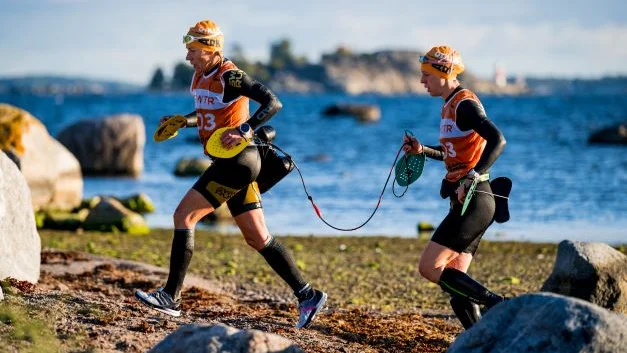If you’re considering your first swimrun event, you can expect a warm welcome from everyone you meet. swimrun is a really friendly and inclusive sport and everyone wants to help each other out.
If you’re considering your first swimrun event, you can expect a warm welcome from everyone you meet. swimrun is a really friendly and inclusive sport and everyone wants to help each other out.
One evening in 2002, in a bar in Stockholm, 4 friends met for drinks. Talking about the beauty of the Stockholm archipelago, the scattering of islands just off Stockholm, one of them pondered whether it would be possible to run and swim the entire length of the archipelago.
At 75km, everyone thought it was a crazy idea and why would you want to do it anyway? Cold water, climbing over rocks? Mad!
A few more drinks ended with a bet. The 4 friends would pair up and race each other across the archipelago, from Uto to Sandhamm . They had to stop at 3 restaurants on the way, with the 2nd team to arrive drinking whatever the 1st team had ordered for them.
The last team to complete the course had to “pay for hotel, dinner and drinks”.
They woke up the next day and completed the first ever swimrun.
Fast forward to 2006 and 2 professional adventure racers, Michael Lemmel and Mats Skott had heard about this mad adventure and created what is now an iconic brand around it. Otillo was born.
Literally translating as ‘Island to Island’, Otillo’s first race was a far cry from what we now know as swimrun, including one team carrying an air mattress with them.
In the years that followed, various iterations happened, including the use of bikes to cross the larger islands and one team creating a rocket shaped tow float, until a format was settled.
By 2009, there were 50 – 60 teams completing the course and a new sport had truly been born. The original course now exists as SwimRun-The world championships, held in September each year.
Since those early years, the sport of swimrun has caught on worldwide, with hundreds of swimrun races in many countries and a real community of swimrun enthusiasts and their families.
The sport has evolved too, with individuals added as a race category in 2019 and different formats being created, from the super long ‘One Water Race’ to super short urban sprint races.
The basis remains the same throughout: swimming and running multiple times, carrying everything with you from start to finish. Being at one with nature.

Swimrun is a sport where teams of 2, either mixed or same sex, or individual athletes complete a course involving multiple segments of running and swimming, without any kit transitions, so participants wear the same kit from start to finish. That means running in your wetsuit and swimming in trainers! Don’t worry, once you’ve practised this it feels like 2nd nature.
Whilst it’s perfectly OK to race solo nowadays, there is something truly bonding about completing an endurance event with someone else right next to you. In many cases, literally tethered to you.
SwimRun can be as minimalist or state of the art as you want. You just have to remember that whatever kit you start with, you’ll be carrying with you right until you finish.
Here’s a rundown of the options, explaining between “no frills, I’m just getting started” and “I’m hooked on swimrun, my wallet is open!”

Over the years, swimrun specific wetsuits have been created. They are unique because:
Are they essential? No. You can get started with a normal shortie wetsuit, but we think you’ll be investing pretty quickly!
Here are some popular swimrun specific wetsuits:
In pretty much every photo of a swimrun, one brand sticks out – ARK. These guys have been born from swimrun and specialise in creating great suit for the sport. From personal experience, they size on the small side, so bear that in mid when choosing.
Another really good brand for swimrun is HEAD. We love their suits. Good quality and they supply entry level right up to high performance suits
Colting are a small Scandinavian swim company with a big history in swimrun.
SwimRunners spend a lot of time in the water with their shoes on.
That means that when you come out of the water and transition to running, you have wet shoes.
What you DON’T want in a swimrun is a pair of shoes with lots of foam which soaks up water and sealed top fabric which holds water in.
The key list of the do’s for swimrun shoes are: Good grip, comfort, drainage and a good lacing system.
Swimruns normally involve trail running. Uneven ground, rocks, soft ground, places where grip is important. This sport puts new and often extreme pressures on the shoes you wear. It’s worth getting this part right very early on in your swimrun journey.
A normal pair of trail running shoes is adequate. Test yours by filling them with water, holding them up and seeing whether the water drains. If it does, great! You’ve got your swimrun shoes.
Pro tip: drill small holes in the soles to help with drainage.
Some popular swimrun shoes are listed here:
Inov8 X-Talon https://www.inov-8.com/running/shoes/swimrun
Salming Elements https://salming.com/en-eu/products/p/1280077-0108/salming-elements-3-men
VivoBarefoot https://www.vivobarefoot.com/uk/events-swimrun
Hoka Speedgoat https://www.hoka.com/
Saucony Peregrine https://www.saucony.com/
VJ Sports https://vjsport.fi/collections/trail-running-shoes
If you’ve watched videos or seen photos of swimrun events, you’ll see most athletes have a pull-buoy.
Are they essential? No. Do they make a difference? The majority says YES.
Neoprene calf sleeves are an alternative, but adding some flotation to the legs to counteract those shoes is a really good idea.
If you’re just starting out, you can use a standard pool pull-buoy, adapting it to be attached whilst you run.
Lots of design work has been done on this subject and there are several really good products out there.
Lets return to Ark for the most popular https://www.arksports.com/collections/pull-buoys
Orca make a really good entry level pull-buoy, with leg attachment already included https://www.orca.com/en-gb/swimrun-pull-buoy-accessory
Swimrunners Piraya is about the biggest size you’ll find whilst still being within the rules. Perfect for heavy legs!
NU is a Spanish company who have designed the Orza.
You don’t want to be carrying a pull-buoy around with you though, so swimrun has developed various novel methods of attaching it to you whilst you run.
Orca include a leg strap, which means the buoy is literally strapped to your leg the whole time. On swim sections, you rotate the buoy between your legs. On run sections, you rotate it out so its on the outside of your leg.
It sounds weird, but you really don’t notice its there, except for an occasional hoist up the leg if it starts slipping.
For the other buoys, We’re going to leave it to our good friends The Low Tide Boyz to explain the lasso system.
A lot of comfort comes from your socks!
High cotton content socks tend to hold on to water and eventually rub your feet into all manner of pain.
High polyester content socks will repel and shed water very quickly.
Yes, swimrunners use hand paddles!
They’ve really become ubiquitous in swimrun events over the last 15 years, as athletes strive for more propulsion, but they come with warnings
One of the few rules in swimrun is that you must remain within 10 metres of your partner if you’re racing as a pair.
Tether’s have become a common piece of kit to both ensure that happens, but they are also really useful if one partner is a stronger swimmer than the other. Swimming fixed in someone’s slip is a fantastic way of conserving energy on the swim legs.
They do take some getting used to and you may need to adapt your stroke slightly.
Compulsory? No.
There are many manufacturers and its not too hard to make your own.
In the UK, Decathlon stock this budget friendly version
Orca make this fantastic quality tether which comes with 2 swimrun belts to hold more gels etc